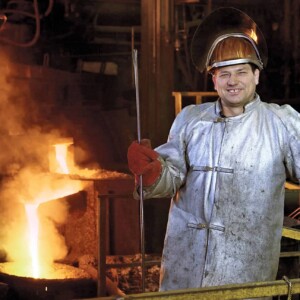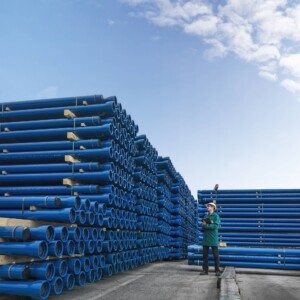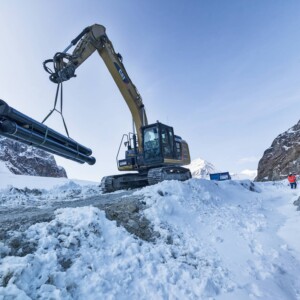Regionality in the hydropower industry – much more than just added value for regions
In spite of ubiquitous globalisation, ‘regionality’ is emerging as an issue of growing importance in the hydropower industry. Regional creation of economic value and awareness of CO2 footprint issues are by far not the only reasons behind this development. Another key factor is the realisation that in-house real net output ratio has a significantly positive effect on a business’s profit generating power. One of the firms that practice and live by the multifaceted concept of ‘regionality’ is well-known pipe system provider Tiroler Rohre GmbH (TRM): Short transportation distances, recyclable materials, long product lifecycles, and the use of renewable forms of energy have earned TRM the reputation of a pioneer in terms of ‘regionality’. One thing seems certain: the advantages of a strong commitment to regionality are not limited to the region as such, but also benefit the customer and, ultimately, the business organisation itself.
Despite its popularity, the concept of ‘regionality’ is lacking a clear, legal definition. While some view it as being limited to district boundaries, others interpret it in broader terms, as extending to national borders, to the German-speaking region, or even to the EU’s outer perimeter. In general, there are two key parameters that are considered to be definitional for the concept of regionality: the effects of keeping transportation expenditures at a low level, and of keeping the value created within the local region. But focussing only on these two aspects would keep issues of ecology and sustainability out of the picture, even though they are essential building blocks of a living commitment to regionality today. Especially when considering the product as such, for example, certain questions arise: Where have its raw materials and the expended energy been sourced, and where is it produced? And what about product quality? Is it a short-lived product that lasts only a few months, or is it designed for decades of continued use? Along the line of answers to these questions it becomes clear to what extent attributing truly sustainable regionality to the product is justified.

Active commitment to regionality
By now, regionality is also gaining in importance in the hydropower industry. For example, a growing number of businesses are committing themselves to a deliberate reduction of their CO2 footprint or regional value creation as part of their Corporate Social Responsibility. One firm that has been playing a pioneering role in this respect in the Alpine region is Tiroler Rohre GmbH, or TRM for short. For 75 years TRM has been developing, producing and marketing high-quality pipe and pile systems that are manufactured from ductile iron at their facility in Hall in Tyrol, Austria. Regionality at TRM is an integral part of the firm’s holistic sustainability concept. “The raw material for our ductile iron pipes and piles is made up of nearly 100% recycled scrap iron, which is recycled after a hundred years of useful product life. Our products have very low operational servicing and maintenance requirements, which prevents waste and saves resources as well as CO2 emissions. We can actually guarantee a low CO2 footprint, thanks to our optimised delivery logistics for our recycling material, and because of short transportation routes to our construction sites,” explains Walter Korenjak, TRM’s Regional Head of Sales for pipe systems in the Austrian market.
A good real net output ratio is well worthwhile
Crucially, firms like TRM have an above-average vertical range of manufacture that translates into a high real net output ratio. A wide-ranging scientific study published jointly by the University of Technology and Economics at Karlsruhe and the ISI department of the Fraunhofer Institute shows a direct correlation between a firm’s real net output ratio and its economic success. The study’s authors devised a model that showed that increasing the real net output ratio by 1% translates into a 0.2% increase in earnings. As it turned out, the real net output ratio is by far the most important explanatory factor for a firm’s likelihood to achieve a yield on sales of more than 2%. Conversely, the authors were unable to find any significant causes for the productivity or profit status of businesses that relied primarily on the use of global delivery chains. One explanation offered by the economists is that possible cost reduction effects might be lost again along the delivery chain due to the higher coordination and organisation costs for ensuring the ability to supply. It seems, therefore, that expanding in-house value creation pays not only in terms of sustainability, but also economically.
Employees: the most valuable capital
Pipe systems specialist TRM is not the only provider to confirm that the real net output ratio is crucial to the hydropower industry. Other suppliers in the industry have been convinced of this for years. One of them is generator specialist Hitzinger, which is headquartered in Linz, Austria. “Our vertical range of manufacture is around 50 to 60 per cent. This adds to our flexibility and overall resilience against crises,” explains Volker Schmid, Business Unit Manager, Alternators & Converters at Hitzinger. Ing. Werner Goldberger, Managing Director of Carinthian-based hydropower allrounder EFG, has a very similar story to tell. When asked, he confirms that his firm achieves a high real net output ratio, adding another important factor to the equation: well-trained employees. “Virtually everything, from construction to manufacturing and installation of our in-house products, is taken care of by our employees. Highly qualified employees are a firm’s economic potential and hallmark. The majority of our employees is from our local region.”
Energy from renewable resources
Where the CO2 footprint is concerned, the energy being used is of course a crucial factor. “We take great care to make our production sustainable – by using photovoltaics, for example. We have already fitted the roofs of our factory halls with photovoltaic modules that generate around 900,000 kilowatt hours a year. We also put our process heat to good use by feeding it into our local district heating grid,” as Max Kloger, TRM’s Owner and Managing Director, explains. Solar power is also the way to go for EFG, as Werner Goldberger explains: “We’ve been serving numerous customers in the hydropower industry for nearly four years now. When it comes to sustainable energy for our own facilities, solar energy is our best bet. We’re currently planning to expand our existing photovoltaic system. This will allow us to cover most of our energy requirements with environmentally friendly energy. The use of self-generated renewable energies alone contributes quite a bit to the region’s creation of value – and it is a climate protection measure well worth taking into account.
Designing for product life cycles that last for decades
With sustainability having a direct bearing on a product’s regionality, its life cycle is a crucial factor as well. High-quality manufacturers such as TRM, EFG or Hitzinger are able to achieve technical product lifespans that sound almost incredible in times of planned obsolescence and disposable products. TRM’s ductile iron pipes, for example, are designed to last for up to 100 years. Likewise, high-quality hydropower machines and components are built to keep running not just for years but for decades. Just like Hitzinger’s generators, for example – a case in point in terms of longevity. “It’s been said that generators of previous generations used to be designed on a larger scale than today’s. But we still put a lot of effort in making sure that none of our machines runs hot, so it can keep running without any problems for decades on end. Our generators are typically designed for a lifespan of 35 to 40 years. But the oldest one of our generators is 70 already,” says Volker Schmid.
Wanted: customer proximity
There is one aspect that is seldom mentioned when it comes to regionality, although it is one of its most essential benefits: customer proximity. Customers appreciate having their project partners close by. As a result, flexibility and immediate availability of resources and trained staff is in higher demand today than ever before. As Walter Korenjak points out, “By producing locally we can contribute a lot to ensuring the overall security of supply for our customers and partners. If you are able to operate more or less independent of global suppliers and make use of local expert knowledge, that allows you to find flexible solutions quickly even in times of crisis. That’s precisely why TRM uses local suppliers and relies on the long-standing experience of in-house trained staff in all of its departments.”
Regionality helps to create value
At TRM, the ability to provide personal on-site services with trained staff is considered another important benefit of regionality. So is the resulting environmentally sensitive approach to implementing projects. As Walter Korenjak explains, it’s not just the environment and the region but the customers that benefit as a result. After all, he says, the key factor in earning the customer’s trust is personal contact with service staff, which is still a top priority at TRM. A small CO2 footprint, as well as sustainable manufacturing practices, a high real net output ratio, the reliability of a trustworthy local employer, short routes of transportation, and staying in close personal contact with the customer: these are the hallmarks of an active commitment to regionality. At the same time, they are a winning formula for firms whose commitment to sustainable development contributes greatly to the prosperity of their local regions. That said, regionality does not necessarily have to stand in absolute opposition to globalised economic concepts. After all, we all are living in a networked world in which niche products are particularly dependent on transregional sales, and in which key components of a global supply chain will therefore remain indispensable. A growing number of hydropower providers are becoming aware of a simple truth: regionality ensures local value creation, which eventually helps to sustain local structures, and with it our climate and our environment.


